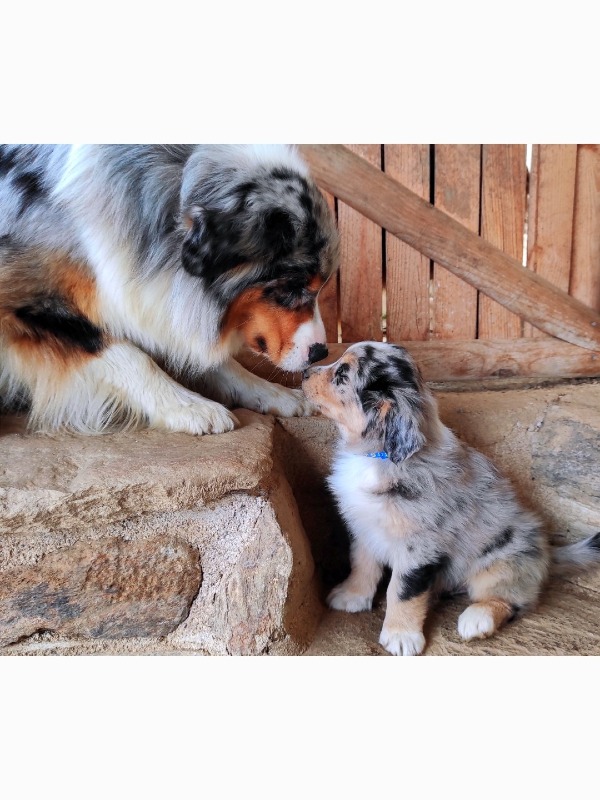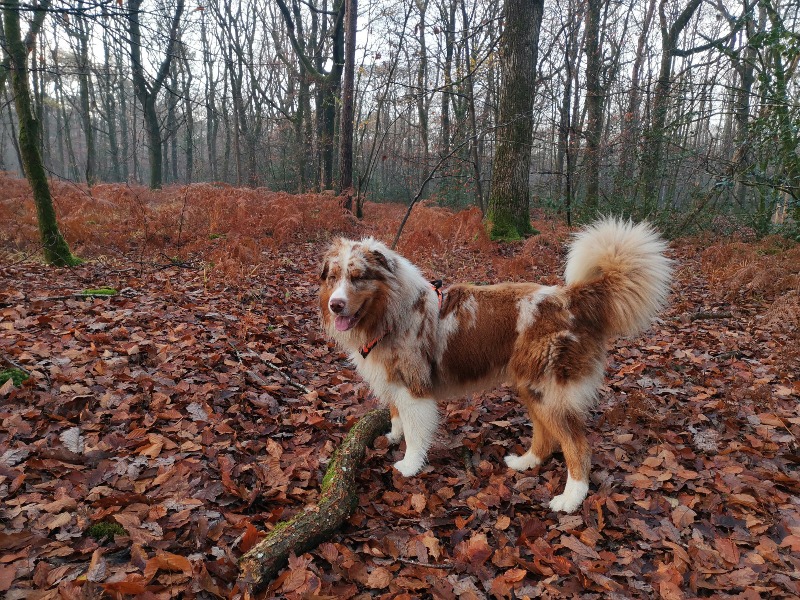Australian shepherd
Welcome to our page dedicated to the breed of dog australian shepherd!
Here, you will find all the useful information about australian shepherd. This descriptive profile will allow you to discover the aspects of this breed. You can notably consult information about the average price, monthly and annual upkeep expenses, their health, name ideas, as well as their official recognition by competent authorities.
Explore this page to discover everything you need to know.
Overall description of the breed
Surprising as it may seem, the Australian Shepherd Dog is not Australian in origin, but American! The breed appeared in the United States at the beginning of the 19th century, from crossbreeding of sheepdogs, mostly imported from Australia. However, its more distant ancestors would be French, more precisely Basque, indeed, many Pyrenean sheepdogs (very good herders) would have been brought back to North America and Australia in the 1800s. This would suggest that the Australian Shepherd Dog's deep roots, before it was selected and developed in the USA, came from the south of France. Although its history is a century old, it was belatedly recognised by world dog organisations, with the International Cynological Federation registering it permanently on 21 May 2007 and its current official standard published on 26 March 2009.
Very popular in North America, the public became acquainted with the Australian Shepherd after the Second World War, at which time it was mainly used as a partner in western riding shows, but also in films, shows and on television. Thanks to these repeated exposures in multiple fields, he was a huge popular success during the second half of the 20th century. Versatile, hardy and intelligent, they are particularly appreciated for their quick learning qualities, obedience and docility, efficient in work, they prove to be an exceptional family dog. Extremely widespread on the North American continent, it made its appearance in Europe during the 1990s, where it met with immense success with the general public. It has been one of the favourite breeds of Europeans (France, Germany, Italy) for several years now, along with the Malinois, the German Shepherd and the Border collie.
The Australian Shepherd has a balanced and elegant morphology, combined with a robust and well-proportioned bone structure. Slightly longer than they are tall, their body is rectangular. Athletic and sporty, his muscles are remarkably well developed, while retaining a natural suppleness and a remarkable lightness of movement, allowing him to remain agile and quick in all circumstances. The tail is straight, short or naturally docked, the topline is straight and strong, with well defined withers, the head is round, with almond-shaped eyes, a bright, lively and alert look, full of intelligence. The coat of the Australian Shepherd is of medium length, straight to wavy, combined with a dense undercoat, which varies with the seasons, protecting it effectively from the weather. The colours accepted by the breed standard are blue-merle, black, red-merle, red, all with or without white patches, with or without tan markings (copper colour), all colours being equal.
The gentle character of the Australian Shepherd is legendary, loyal and close to its owners, the Australian Shepherd has an innate sociability and a pronounced taste for obedience. They enjoy playing with family members and other dogs, and can also be very efficient and effective at work, especially at driving and guarding flocks. Like all sheepdogs, he has a natural distrust of people he does not know, but after a period of confidence building, he is an affectionate companion even with people he does not know. His temperament is often fusional with his owners... If you decide to adopt an Australian Shepherd, you should know that he does not tolerate solitude, you will have to give him time and attention, on the one hand to meet his daily expenses, on the other hand, to satisfy his need to be loved!
In conclusion, the Australian Shepherd is a docile, intelligent dog, easy to train and particularly attentive to its environment. It is an ideal partner for sportsmen, as well as for people who like to share activities with their pets, playful and sociable, it will accompany you with pleasure and determination in all your daily adventures!
Adult: The Australian Shepherd Dog will weigh 55 - 74 lbs for males and 41 - 57 lbs for females, his height at the withers will be 20" - 23" for males and 18" - 21" for females.
Awareness of acquiring an animal
Each animal is a sensitive being, deserving love, attention and care.
When you choose to adopt an animal, you take on the responsibility of ensuring its health and well-being throughout its life.
To learn more about animal welfare, we invite you to consult our FAQ by clicking the button below:
Origins
The Australian Shepherd, despite its name, is not originally from Australia but from the United States. This breed was developed in the late 19th and early 20th centuries by American livestock breeders, mainly in the California regions. The Australian Shepherd is descended from shepherd dogs imported by the Basques from their original regions, mainly Spain and France, where they worked with Merino sheep. These dogs were crossed with other breeds of shepherd dogs to improve their skills and adaptability. The breed was crafted to meet the specific needs of American farmers and ranchers, especially for herding and guarding herds in various conditions.
History
The history of the Australian Shepherd is closely linked to the development of livestock farming in the United States. Contrary to what its name suggests, this breed is not originally from Australia. It was developed in the 19th and early 20th centuries by American breeders who were looking for an agile, intelligent, and hardy herding dog to work with their herds. The ancestors of the Australian Shepherd include herding dogs imported by Basque shepherds from Australia and Europe. These dogs were crossed with other breeds to create a dog perfectly suited to the needs of American ranches. The Australian Shepherd became popular in the 1950s thanks to rodeo and horse shows, where it demonstrated its exceptional skills as a working dog.
Standard
The breed standard for the Australian Shepherd is defined by several cynological organizations, including the Fédération Cynologique Internationale (FCI) and the American Kennel Club (AKC). The Australian Shepherd is a medium-sized dog, well proportioned and solidly built. Males measure between 51 and 58 cm at the withers, while females measure between 46 and 53 cm. The weight generally ranges from 18 to 29 kg. The head is well proportioned with a slightly rounded skull and a moderate length muzzle. The eyes are almond-shaped, and can be blue, brown, amber, or heterochromatic. The ears are medium-sized and triangular, set high. The coat is of medium length, straight to wavy, with a dense undercoat. Acceptable colors include blue merle, red merle, black, and red, with or without white and copper markings.
Physical characteristics
The Australian Shepherd is a medium-sized, robust, and well-proportioned dog. Males measure between 51 and 58 cm at the withers and weigh between 25 and 32 kg, while females measure between 46 and 53 cm and weigh between 18 and 25 kg. Their coat is of medium length, straight or slightly wavy, with a dense undercoat that protects them from the weather. Coat colors include blue merle, red merle, black, and red, often accompanied by white and tan markings. Australian Shepherd's eyes are almond-shaped and can be blue, brown, amber, or heterochromatic. The ears are of medium size, triangular, and set high, falling forward or to the sides when the dog is attentive.
Character
The Australian Shepherd is known for its exceptional intelligence, versatility, and boundless energy. It is a devoted working dog, always ready to take on challenges. It is very attached to its family and shows great loyalty and affection towards its owners. This dog is sociable and friendly, but can be reserved with strangers, making it a good guard dog. It is also very protective and attentive. The Australian Shepherd is an ideal companion for active families and outdoor enthusiasts. Its intelligence and desire to learn make it a perfect candidate for dog sports such as agility, obedience, flyball, and herding work.
Life expectancy
The Australian Shepherd enjoys a relatively long life expectancy, typically between 12 and 15 years. This longevity depends on several factors, including a balanced diet, regular veterinary care, and an active lifestyle. Owners must monitor their dog's health closely, especially common health issues in this breed such as hip dysplasia, eye abnormalities, and autoimmune diseases. Regular medical check-ups and special attention to physical exercise and mental stimulation contribute to a long and healthy life for the Australian Shepherd. With proper care, this robust dog can be a faithful companion for many years.
Exercise and activity needs
The Australian Shepherd is an extremely active breed that needs a lot of exercise to stay healthy and happy. It requires at least one to two hours of intense physical activity per day. This can include long walks, running, fetch games, and canine sports sessions such as agility or flyball. In addition to physical exercise, the Australian Shepherd also needs mental stimulation. Intelligence games, dog puzzles, and regular training sessions are essential to prevent boredom and destructive behaviors. This breed thrives in an environment where it can work and expend energy, making it an excellent companion for active families and outdoor enthusiasts.
Recommended diet
The Australian Shepherd's diet must be balanced and adapted to its high energy needs. A high-quality diet, rich in proteins and essential nutrients, is recommended to maintain its health and vitality. In general, an adult Australian Shepherd consumes between 250 and 350 grams of dry food per day, divided into two meals. The monthly cost of food ranges between 50 and 100 euros, depending on the quality of the products chosen. It is crucial to monitor its weight and not overfeed it, as obesity can lead to various health problems. Owners may also consider dietary supplements, such as omega-3, to support skin and joint health.
Training and obedience
The Australian Shepherd is an extremely intelligent and receptive dog, which makes it easy to train. It learns quickly and enjoys challenges, making it an ideal student for various types of training. Positive reinforcement methods, such as rewards and praise, are particularly effective with this breed. It is essential to start its education at a young age to establish good habits and prevent undesirable behaviors. Early socialization is also crucial for the Australian Shepherd, exposing it to various people, animals, and environments. Obedience classes and canine sports, such as agility, flyball, and obedience, are excellent ways to stimulate its active mind and strengthen the bond between the dog and the owner.
Behavior with children
The Australian Shepherd is generally excellent with children, thanks to its friendly, patient, and protective temperament. It is often very affectionate and enjoys playing with the younger members of the family, becoming a loyal and attentive companion. However, due to its natural herding instinct, it may sometimes try to "herd" the children, which can include behaviors like nipping at heels. It is important to supervise interactions between the dog and young children and teach them to respect the dog and interact with it appropriately. With proper socialization and education, the Australian Shepherd can be a great addition to a family with children.
Compatibility with Other Animals
The Australian Shepherd can harmoniously coexist with other pets, especially if socialized from a young age. Its herding instinct may sometimes show in its interactions with other animals, but it is generally friendly and playful. With proper socialization and introduction, the Australian Shepherd can get along well with other dogs and even cats. However, it is important to monitor initial interactions to ensure they are smooth. Overall, the Australian Shepherd adapts well to life with other pets, bringing a positive and energetic dynamic to the household. The key is to promote positive experiences and reinforce good behavior.
Grooming needs
The Australian Shepherd has a medium-length coat that requires regular maintenance to stay in good condition. Weekly brushing is recommended to remove dead hair and prevent knots and tangles. During shedding periods, in spring and autumn, brushing should be increased to manage excess hair. Baths are only necessary occasionally, or when the dog is particularly dirty, using a gentle dog shampoo. Ears should be checked and cleaned regularly to prevent infections, and teeth should be brushed frequently to avoid dental problems. Nails should be trimmed regularly to prevent injuries.
Health
The Australian Shepherd is generally a robust breed, but it can be prone to certain hereditary health conditions. Common problems include hip and elbow dysplasia, eye abnormalities such as cataracts and progressive retinal atrophy, and autoimmune diseases. It is crucial to choose a reputable breeder who tests their dogs for these conditions to minimize risks. A balanced diet, regular exercise, and periodic veterinary visits are essential to maintain their health. The Australian Shepherd has an average lifespan of 12 to 15 years, and with proper care, it can live a long and healthy life. Owners should be attentive to any signs of discomfort and regularly consult a veterinarian for health check-ups.
Average price
The price of an Australian Shepherd can vary considerably depending on several factors, such as lineage, pedigree, breeder reputation, and geographical location. In general, the average price for an Australian Shepherd puppy ranges from 800 to 1,800 euros. Specimens from champion lineages or with exceptional characteristics can cost much more, sometimes up to 2,500 euros or more. It is essential to choose a reputable breeder who adheres to health and animal welfare standards. While this may mean paying a higher price, it often guarantees a healthy and well-socialized puppy. Prospective owners should also budget for additional expenses for veterinary care, food, accessories, and training.
Expenses
Monthly expenses for an Australian Shepherd can vary depending on several factors, including food, veterinary care, grooming, and accessories. On average, owners can expect to spend between 60 and 120 euros per month. Quality food, tailored to the specific needs of the breed, costs around 40 to 70 euros per month. Regular veterinary care, including vaccinations and parasite treatments, can add 10 to 30 euros per month. Grooming, though minimal, can cost 10 to 20 euros per month if done by a professional. Toys, treats, and other accessories can add an additional 10 to 20 euros. These costs can vary depending on each dog's specific needs and the owner's choices.
Name ideas
Choosing a name for your Australian Shepherd can be a fun and exciting task. Here are some name suggestions that might suit the personality and appearance of this dynamic breed: Max, Luna, Rocky, Bella, Zeus, Daisy, Charlie, Maya, Finn, Ruby, Oscar, Zara, Nala, Leo, Rosie, Milo, Sadie, Rex, Ginger, Toby. When choosing a name, it is important to consider its pronunciation and make sure it does not sound too much like basic commands to avoid any confusion during training. Take the time to observe your dog and choose a name that reflects its unique personality and lively, energetic appearance.
Legislation and regulation
In France, the Australian Shepherd is not classified as a dangerous dog breed and is therefore not subject to specific restrictions. However, owners must comply with general regulations regarding dog ownership, including microchip or tattoo identification, and up-to-date vaccination. It is also recommended to take out civil liability insurance to cover any potential damages caused by their dog. When traveling abroad, it is crucial to check the specific requirements of the destination country regarding health certificates and vaccinations. Always inquire about local and national laws to avoid any legal issues and ensure a harmonious cohabitation with the Australian Shepherd.
Official recognition
The Australian Shepherd is recognized by several cynological organizations around the world. In France, it is recognized by the Société Centrale Canine (SCC). Internationally, it is recognized by the Fédération Cynologique Internationale (FCI), the American Kennel Club (AKC) in the United States, the Kennel Club (KC) in the United Kingdom, and the Canadian Kennel Club (CKC) in Canada. These organizations define the breed standards and organize dog shows where Australian Shepherds can be presented and evaluated. Recognition by these organizations also ensures that breeders adhere to health, temperament, and conformation standards, contributing to the preservation and improvement of the breed.
Pedigrees
Australian Shepherds can obtain pedigrees recognized by various breed clubs around the world, ensuring their pure lineage and conformity to breed standards. In France, the Société Centrale Canine (SCC) issues pedigrees. In the United States, the American Kennel Club (AKC) offers pedigrees for Australian Shepherds. In the United Kingdom, the Kennel Club (KC) also issues pedigrees for this breed. Other clubs include the Canadian Kennel Club (CKC) in Canada, and the Fédération Cynologique Internationale (FCI) internationally. These organizations verify the dogs' origins and certify that they meet breed criteria, guaranteeing the quality and purity of the bloodlines.
Destination and usage
The Australian Shepherd is primarily bred as a working and companion dog. Thanks to its intelligence, energy, and versatility, it excels in many areas, including herding, dog sports such as agility, obedience, flyball, and frisbee. This breed is also used as therapy dogs and search and rescue dogs due to its stable temperament and quick learning ability. The Australian Shepherd is an excellent companion for active families and individuals who enjoy outdoor activities. Its protective and loyal nature also makes it a good watchdog. In summary, the Australian Shepherd is a versatile dog, capable of adapting to various roles and environments.
Prohibitions
In France, the Australian Shepherd is not among the breeds of dogs considered dangerous and therefore is not subject to specific prohibitions. However, it is essential to comply with general regulations regarding the possession of dogs, especially in terms of identification, vaccination and compliance with local laws regarding dogs in public. In other countries, regulations may vary. For example, some regions may impose restrictions on the possession of bully breeds or specific requirements for owners. It is crucial to inquire about local and national laws, especially when traveling or moving, to avoid any violations.
Breeders ofAustralian shepherd
Want to see more breeders ofAustralian shepherd?
Check out the page of our directory listing all breeders ofAustralian shepherdClassified Ads ofAustralian shepherd
Want to see more ads ofAustralian shepherd?
Check out the page listing all the ads ofAustralian shepherdBreed clubs ofaustralian shepherd
No ofaustralian shepherd breed clubs are currently registered on Preeders.
If you would like to highlight your breed club, sign up for free now and be the first to appear on this page.















